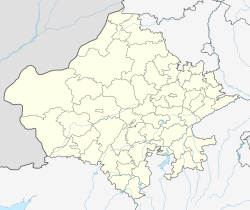Dundlod
|
Dundlod |
|
|---|---|
| town | |
| Location in Rajasthan, India | |
| Coordinates: 27°54′00″N 75°12′59″E / 27.9000°N 75.2165°ECoordinates: 27°54′00″N 75°12′59″E / 27.9000°N 75.2165°E | |
| Country |
|
| State | Rajasthan |
| District | Jhunjhunu |
| Elevation | 354 m (1,161 ft) |
| Languages | |
| • Official | Hindi |
| Time zone | IST (UTC+5:30) |
| PIN | 333 702 |
| Telephone code | 91-1594 |
| Vehicle registration | RJ-18 |
| Nearest city | Nawalgarh |
| Distance from Bidsar () | 6 kilometres (3.7 mi) (land) |
| Avg. summer temperature | 46–48 °C (115–118 °F) |
| Avg. winter temperature | 0–1 °C (32–34 °F) |
Dundlod (Hindi: ) (Rajasthani: डळौद) is a town in Jhunjhunu district of Rajasthan in India. It is situated in the Shekhawati region of Rajasthan. It is famous for its fort and havelis. It extends between latitude 28°.06’ in the north and longitude 75°.20’ in the east. It lies about seven kilometers north of Nawalgarh in the heart of the Shekhawati region.
Dundlod was a thikana of Shekhawat rulers under Jaipur state. Its fort was built in 1750 by Keshari Singh, the fifth and youngest son of a Rajput ruler Sardul Singh. Major additions were made in the early 19th century by his descendant Sheo Singh. Dundlod can be reached by road from Delhi, Jaipur, and Bikaner. Members of the wealthy Goenka merchant family also settled at Dundlod and their prosperity is evident in their richly fresco painted havelis here. The beautiful Chhatri of Ram Dutt Goenka and the adjacent well were both built by Ram Chandra Goenka in 1888.
Dundlod fort is a blend of the Rajput and Mughal art and architecture. The Diwan- e- Khas (Hall of private audience) has stained glass windows, fine antiques and an impressive library. The zenana quarters are on the 1st floor featuring exquisite decors and furniture. The fort is converted into a cozy and comfortable abode. The dress code of the state and grand hospitality with the horse guards are an attractive factor.
Close to the fort lies the Chhatri of Ram Dutt Goenka, which has an adjacent well. Built in 1888, the dome has floral motifs with banners extending from the centre. The dome is encircled by frieze showing Krishna dancing with his gopis, interspersed with musicians and peacocks. The paintings around the inner base show war panorama of Mahabharata. The Bhagirath Mal Goenka Haveli is a fine example mirror work on the windows of the upper walls of the inner courtyard. Notable are delicately preserved paintings mostly in round frames. Also worth a visit is the Satyanarayan Temple built by the Goenka family. On the walls of the temple is a huge fresco with modern trappings showing British men and women on bicycles and cars, it also shows a long train and has a backdrop of telegraph wires. A painting under the roof in the upper space shows a noble in leisure either smelling flowers or reading books. Another painting shows a turbaned man holding a bird while yet another portrays a woman admiring herself in the mirror.
...
Wikipedia


